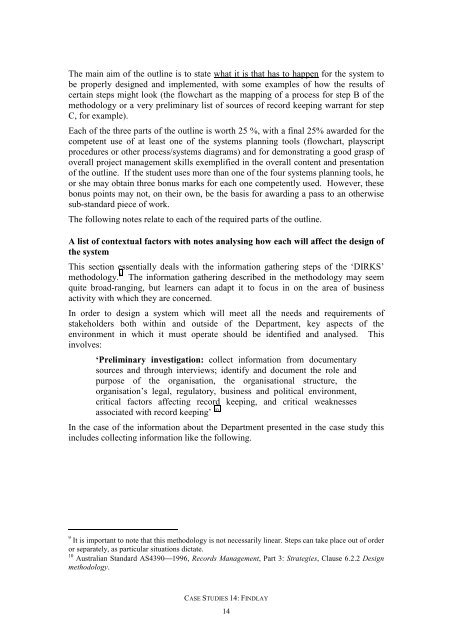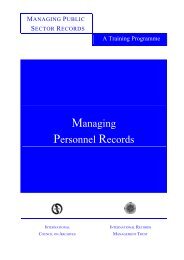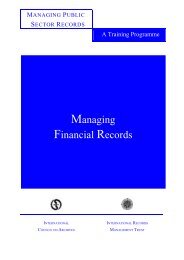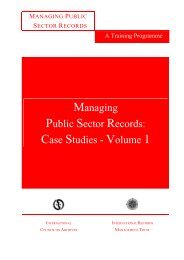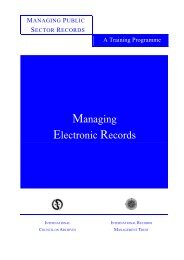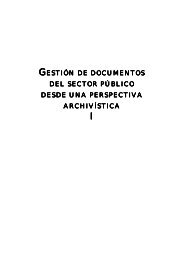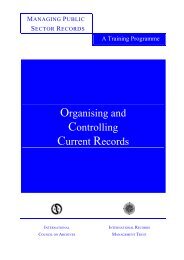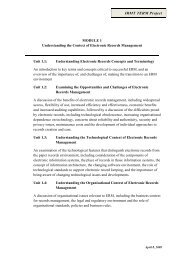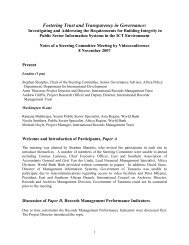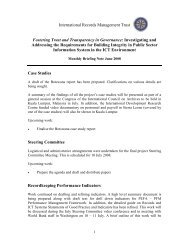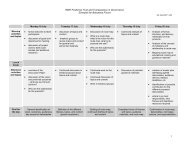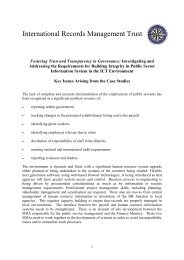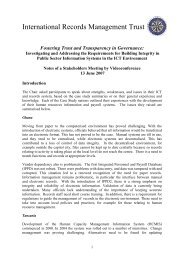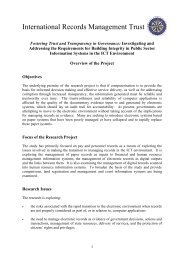managing public sector records: a study programme - International ...
managing public sector records: a study programme - International ...
managing public sector records: a study programme - International ...
Create successful ePaper yourself
Turn your PDF publications into a flip-book with our unique Google optimized e-Paper software.
The main aim of the outline is to state what it is that has to happen for the system to<br />
be properly designed and implemented, with some examples of how the results of<br />
certain steps might look (the flowchart as the mapping of a process for step B of the<br />
methodology or a very preliminary list of sources of record keeping warrant for step<br />
C, for example).<br />
Each of the three parts of the outline is worth 25 %, with a final 25% awarded for the<br />
competent use of at least one of the systems planning tools (flowchart, playscript<br />
procedures or other process/systems diagrams) and for demonstrating a good grasp of<br />
overall project management skills exemplified in the overall content and presentation<br />
of the outline. If the student uses more than one of the four systems planning tools, he<br />
or she may obtain three bonus marks for each one competently used. However, these<br />
bonus points may not, on their own, be the basis for awarding a pass to an otherwise<br />
sub-standard piece of work.<br />
The following notes relate to each of the required parts of the outline.<br />
A list of contextual factors with notes analysing how each will affect the design of<br />
the system<br />
This section essentially deals with the information gathering steps of the ‘DIRKS’<br />
methodology. 9 The information gathering described in the methodology may seem<br />
quite broad-ranging, but learners can adapt it to focus in on the area of business<br />
activity with which they are concerned.<br />
In order to design a system which will meet all the needs and requirements of<br />
stakeholders both within and outside of the Department, key aspects of the<br />
environment in which it must operate should be identified and analysed. This<br />
involves:<br />
‘Preliminary investigation: collect information from documentary<br />
sources and through interviews; identify and document the role and<br />
purpose of the organisation, the organisational structure, the<br />
organisation’s legal, regulatory, business and political environment,<br />
critical factors affecting record keeping, and critical weaknesses<br />
associated with record keeping’ 10<br />
In the case of the information about the Department presented in the case <strong>study</strong> this<br />
includes collecting information like the following.<br />
9<br />
It is important to note that this methodology is not necessarily linear. Steps can take place out of order<br />
or separately, as particular situations dictate.<br />
10<br />
Australian Standard AS4390⎯1996, Records Management, Part 3: Strategies, Clause 6.2.2 Design<br />
methodology.<br />
CASE STUDIES 14: FINDLAY<br />
14


